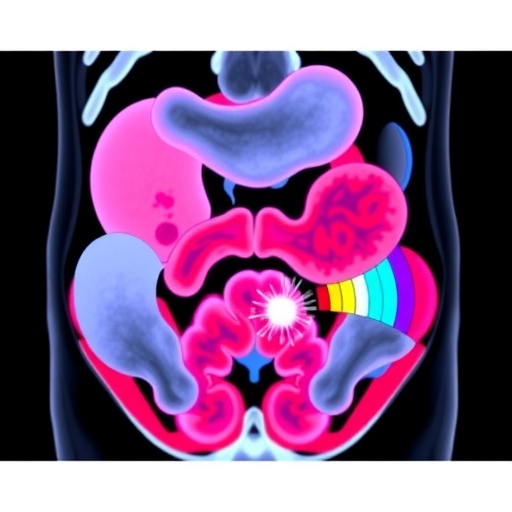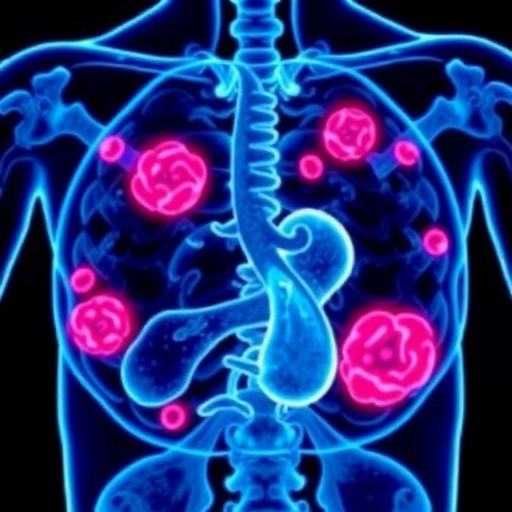In a remarkable stride toward enhancing the precision of rectal cancer diagnostics, researchers have unveiled an innovative approach that synergizes advanced imaging techniques to differentiate tumor grades with unprecedented accuracy. The study, spearheaded by Wang and colleagues, explores the integration of virtual magnetic resonance elastography (vMRE), fractional order calculus (FROC) diffusion modeling, and diffusion-weighted imaging (DWI) to overcome longstanding challenges in grading rectal cancer. This breakthrough holds transformative potential for personalized oncology, guiding more effective treatment strategies and improving patient outcomes.
Rectal cancer remains a critical global health concern, with tumor grading playing a pivotal role in determining prognosis and therapeutic direction. Traditional diagnostic methods, while informative, often fall short in accurately distinguishing between low- and high-grade malignancies due to the tumor’s complex microstructural heterogeneity. Advanced imaging modalities have emerged as non-invasive alternatives, yet their individual capabilities have limitations. The novel multi-parametric approach introduced in this study represents a quantum leap by combining complementary imaging parameters to amplify diagnostic fidelity.
Central to this cutting-edge method is virtual magnetic resonance elastography (vMRE), which quantifies tissue stiffness by simulating mechanical properties through MRI data processing. Since malignant tissues typically exhibit altered viscoelastic characteristics, vMRE provides crucial biomechanical insights that correlate with tumor aggressiveness. Complementing this is the fractional order calculus (FROC) diffusion model, a sophisticated mathematical framework that captures anomalous diffusion patterns in tissues beyond the conventional Gaussian assumptions. FROC parameters elucidate subtle microenvironmental changes reflective of cellular density and matrix composition.
Diffusion-weighted imaging (DWI), a well-established technique measuring the apparent diffusion coefficient (ADC) of water molecules within tissues, completes the triad. While ADC values have long been associated with tumor cellularity, their diagnostic power alone is often insufficient for definitive grading. By juxtaposing DWI metrics with the nuanced data harvested from FROC modeling and vMRE, the research team achieved a multi-dimensional portrayal of tumor physiology that bolsters accuracy.
The prospective study encompassed 74 patients diagnosed with rectal cancer who underwent comprehensive pelvic MRI scans incorporating these advanced modalities. Rigorous statistical analyses including Mann–Whitney U tests and independent t-tests were employed to compare the imaging parameters across low-grade and high-grade tumor groups. Subsequent logistic regression and receiver operating characteristic curve (ROC) analyses assessed the diagnostic potential of individual parameters as well as combined models, quantifying their discriminative power through area under the curve (AUC) metrics.
Notably, the study revealed that high-grade rectal cancers exhibited significantly elevated vMRE-derived shear modulus (µ_MRE) and FROC-derived µ values, indicating increased tissue stiffness and complexity. Conversely, values of diffusion coefficients D and β, alongside ADC, were markedly reduced in high-grade tumors, reflecting restricted diffusion consistent with denser, more aggressive neoplastic tissue. These statistically significant differences underscore the capability of integrating biomechanical and diffusion-based biomarkers to effectively stratify tumor grades.
Among the parameters, the D value from the FROC diffusion model demonstrated the highest standalone diagnostic efficacy with an AUC of 0.852, outperforming traditional ADC measurements from DWI. However, the true power emerged when combining FROC parameters D, β, and µ, which yielded an impressive AUC of 0.943. This combined model’s superiority was statistically validated against both DWI and vMRE alone, signifying a synergistic enhancement in tumor grading accuracy.
Intriguingly, the analysis revealed meaningful correlations between parameters; µ_MRE showed moderate negative associations with ADC, D, and β, highlighting inverse relationships between tissue stiffness and diffusion properties. Simultaneously, µ_MRE correlated positively with the FROC µ parameter, reinforcing the complementary nature of elastography and diffusion metrics in characterizing tumor microstructure. These inter-parameter dynamics illuminate complex physiological interactions that single-modality imaging cannot fully capture.
This study’s methodological rigor and technical sophistication mark an important advance in oncologic imaging research. By harnessing the mathematical versatility of fractional calculus alongside biomechanical modeling through vMRE, the researchers have provided a powerful toolkit to non-invasively interrogate tumor heterogeneity. The proposed multiparametric model paves the way for more accurate, reliable, and clinically actionable assessments that can tailor therapeutic interventions to individual patient profiles.
Beyond rectal cancer, the implications of integrating FROC and vMRE with conventional diffusion imaging extend broadly across oncologic and non-oncologic conditions characterized by altered tissue architecture and mechanics. This interdisciplinary approach bridges mathematics, physics, and radiology, exemplifying the transformative potential of computational imaging biomarkers in modern medicine. Future investigations may explore machine learning algorithms to automate parameter extraction and classification, further streamlining clinical translation.
In summary, Wang et al.’s pioneering research demonstrates that incorporating virtual magnetic resonance elastography and fractional order calculus diffusion modeling significantly refines the differentiation of rectal cancer grades compared to standard diffusion-weighted imaging alone. This diagnostic enhancement heralds a paradigm shift toward more nuanced, multi-parametric imaging strategies that better reflect tumor biology. As precision medicine continues to evolve, such integrative imaging modalities will become indispensable in optimizing cancer management pathways.
The advent of these technologies aligns with the broader trend of personalized oncology, emphasizing detailed tumor characterization over one-size-fits-all approaches. With validation in larger, multicenter cohorts, this multi-parametric imaging framework could soon influence clinical guidelines, enabling earlier detection of aggressive disease and informing surgical and adjuvant therapy decisions. Ultimately, patients stand to benefit from improved survival rates and quality of life through tailored therapeutic regimens informed by robust, non-invasive diagnostic tools.
While challenges remain in widespread implementation, including technical standardization and reproducibility, the foundational discoveries presented in this study offer a compelling vision for the future of cancer imaging. Combining rigorous mathematical modeling with advanced MRI techniques exemplifies how interdisciplinary innovation drives meaningful clinical progress. The integration of vMRE and FROC diffusion models into routine practice may redefine diagnostic benchmarks, fostering a new era of precision diagnostics that can adapt dynamically to tumor complexity.
This synthesis of elastography and fractional calculus embodies the cutting edge of bioengineering and radiologic science. It establishes a fertile research avenue for developing more sophisticated imaging biomarkers capable of probing the microenvironmental underpinnings of malignancy. By leveraging these insights, clinicians can gain unparalleled clarity into tumor behavior, enhancing prognostication and personalized treatment strategies for rectal cancer and beyond.
In conclusion, the application of virtual magnetic resonance elastography alongside fractional order calculus diffusion modeling represents a transformative advancement in rectal cancer imaging. The study by Wang et al. exemplifies how integrating biomechanical and diffusion parameters yields superior diagnostic accuracy for tumor grading. As this multiparametric approach gains traction, it promises to elevate the standard of care, delivering more precise, individualized cancer treatment in the near future.
—
Subject of Research: Differentiation of rectal cancer grades using advanced MRI techniques combining virtual magnetic resonance elastography and fractional order calculus diffusion models.
Article Title: Differentiating rectal cancer grades using virtual magnetic resonance elastography and fractional order calculus diffusion model
Article References: Wang, S., Jin, X., Ba, Y. et al. Differentiating rectal cancer grades using virtual magnetic resonance elastography and fractional order calculus diffusion model. BMC Cancer 25, 734 (2025). https://doi.org/10.1186/s12885-025-13983-7
Image Credits: Scienmag.com
DOI: https://doi.org/10.1186/s12885-025-13983-7
Tags: advanced imaging techniquesdiffusion-weighted imaging in oncologyenhancing patient outcomes in cancer carefractional order calculus diffusion modelingmechanical properties of tumorsmulti-parametric imaging approachesnon-invasive cancer diagnosispersonalized cancer treatment strategiesrectal cancer diagnosticsrectal cancer prognosistumor grading accuracyvirtual magnetic resonance elastography






